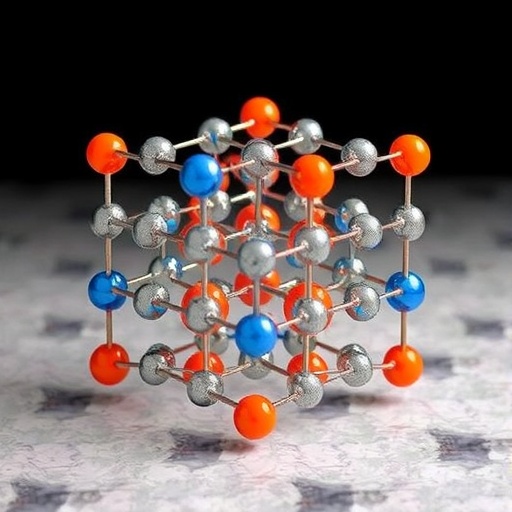A groundbreaking development in the field of materials science has emerged from the collaborative efforts of researchers Shi, Rosen, Schäfer, and their team, presenting a transformative computational framework designed to unravel the complexities of surface chemistry in ionic materials. This innovative approach, recently published in Nature Chemistry, paves the way for unprecedented accuracy and efficiency in modelling the dynamic interactions that dictate the functionality and stability of ionic surfaces across a wide array of technological applications.
Surfaces of ionic materials play an indispensable role in numerous scientific and industrial processes, ranging from catalysis and sensing to energy storage and electronic device fabrication. However, accurately predicting surface phenomena has long challenged scientists due to the intricate balance of electrostatic forces, atomic interactions, and environmental effects that govern surface behaviors. The new framework addresses these challenges head-on by integrating advanced theoretical models with cutting-edge computational techniques, enabling detailed simulations that capture the true complexity of these systems.
At the core of this method lies a sophisticated algorithmic structure that seamlessly combines quantum mechanical principles with large-scale molecular dynamics simulations. This hybrid approach allows the team to scale their calculations without sacrificing the atomic-level detail necessary to understand nuanced chemical interactions on ionic surfaces. By achieving this balance, the framework transcends previous limitations where either accuracy or computational feasibility had to be compromised, marking a significant leap in the modelling paradigm.
One of the standout features of this work is the precise description of electrostatic environments surrounding ionic surfaces. The researchers implemented a novel treatment of long-range Coulombic interactions, which often present formidable computational bottlenecks due to their infinite-range character. By innovatively partitioning and efficiently summing these interactions within a hierarchical scheme, the team realized a dramatic reduction in computational cost while maintaining stringent accuracy standards.
This computational efficiency has immediate practical implications. The framework can now be applied to simulate surface reactions under various conditions, including temperature fluctuations, different atmospheric compositions, and mechanical strain, parameters that are crucial for predictive design in catalysis and material durability. Notably, the approach has already demonstrated remarkable consistency with experimental observations, significantly narrowing the gap between theoretical predictions and real-world behaviors.
Beyond the immediate scope of ionic surfaces, the methodology offers a versatile platform adaptable to other classes of materials exhibiting complex surface chemistry, such as mixed ionic-electronic conductors and hybrid organic-inorganic interfaces. This adaptability stems from the framework’s modular architecture, which facilitates the incorporation of material-specific parameters and environmental factors, enabling tailored simulations across diverse chemical landscapes.
The researchers also emphasize the usability of their framework, highlighting its integration into accessible computational packages commonly utilized in materials science. This democratization of advanced modelling tools promises to accelerate research across academia and industry alike, empowering scientists to explore surface phenomena with newfound precision and speed.
Importantly, by fostering deeper understanding of surface mechanisms, this work opens avenues for the rational design of materials with enhanced properties. For instance, optimizing the surface chemistry of electrode materials in batteries could lead to improved cycle life and energy density. Similarly, catalytic materials could be engineered for higher selectivity and turnover rates by manipulating surface states predicted through these simulations.
The implications extend into environmentally critical domains as well. Predictive modelling of mineral surfaces interacting with pollutants or greenhouse gases can inform strategies for remediation and carbon capture technologies. Detailed insights into surface adsorption and reaction pathways gleaned from this framework may offer unprecedented control over such processes.
Moreover, this framework contributes significantly to the ongoing effort to bridge experimental and theoretical realms in surface science. By providing a reliable computational counterpart to surface-sensitive techniques such as scanning tunneling microscopy and photoelectron spectroscopy, it enables a more holistic interpretation of experimental data and guides the design of targeted studies.
While the framework signifies a monumental step forward, the authors acknowledge areas ripe for future exploration. Enhancing the treatment of dynamic charge transfer processes and incorporating more sophisticated descriptions of quantum nuclear effects remain as promising directions. These advances would further elevate the realism and predictive power of simulations, especially for systems where electron correlation and nuclear quantum phenomena play critical roles.
This study exemplifies the transformative power of interdisciplinary collaboration, blending expertise from computational physics, chemistry, and materials engineering. The fusion of theoretical rigor with algorithmic innovation encapsulates the spirit of modern scientific inquiry, where complex challenges are met through integrative problem-solving strategies.
The broader scientific community has greeted this development with enthusiasm, recognizing its potential to recalibrate approaches not only in surface chemistry but also in related fields like catalysis, corrosion science, and biomaterial interfaces. Workshops and symposia are already being organized to disseminate knowledge and promote the adoption of the framework internationally.
In a world increasingly dependent on advanced materials for sustainable technologies and novel devices, tools that enable precise control and understanding of surface properties are invaluable. This framework equips scientists and engineers with an unprecedented capability to navigate the atomic landscape of ionic surfaces, thereby catalyzing innovation across sectors.
Ultimately, the introduction of this accurate and efficient modelling framework represents a milestone in computational materials science. It transcends existing hurdles, furnishing researchers with a powerful lens through which the hidden chemistry of ionic surfaces can be observed and manipulated. The ripple effects of this advancement are likely to resonate through scientific literature and practical applications for years to come, cementing its place as a cornerstone in the future of materials design.
Subject of Research: Surface chemistry modelling of ionic materials
Article Title: An accurate and efficient framework for modelling the surface chemistry of ionic materials
Article References:
Shi, B.X., Rosen, A.S., Schäfer, T. et al. An accurate and efficient framework for modelling the surface chemistry of ionic materials. Nat. Chem. (2025). https://doi.org/10.1038/s41557-025-01884-y
Image Credits: AI Generated




